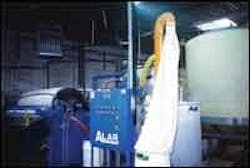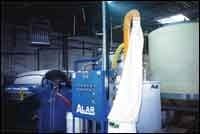Recycled Antifreeze Basics
The goal of stripping, says Gunderson, is to reduce the spent coolant to ethylene glycol (the base for virtually all antifreeze) and purified water. The stripping methods generally accepted as best, he says, are ion exchange, distillation and reverse osmosis.
Ion exchange works much like a water softener to clean spent coolant, while distillation employs heat and vacuum. (Distillation also removes water, yielding only ethylene glycol.) In reverse osmosis, spent coolant is flooded over spirally wrapped membranes that selectively allow ethylene glycol and water to pass, while resisting the passage of contaminants.
Recycle Technologies employs reverse osmosis, but first pre-strips the old coolant in two stages. First, the coolant is "chemically filtered" or "shocked" by mixing it with chemicals that precipitate dissolved solids. The shocked coolant is then drawn through a rotary vacuum filter, a large, fabric-covered cylinder coated with several inches of diatomaceous earth, a natural filtering material.
The shocked and filtered coolant, now cleaned of 80 percent of its contaminants, is then subjected to a two-stage reverse-osmosis treatment. The end product, says Gunderson, is ethylene glycol that is as pure as new, plus demineralized water.
Gunderson then blends in additives (supplied by Penray) to create Recycle Technologies' range of Maxsafe antifreezes, sold as a 50/50 blend of antifreeze and demineralized water. Gunderson routinely has Maxsafe products analyzed against new-antifreeze specifications as a check on quality.
If you're looking for an antifreeze recycler, Gunderson has these suggestions. First, make sure the firm uses an effective stripping method (not just mechanical or chemical filtering). Also, determine that the additives come from a reputable supplier. The recycler should have on file written verification that the additive package (when blended with ethylene glycol compliant with ASTM standard E-1177) produces antifreeze meeting such industry standards as ASTM D-6210, Technology & Maintenance Council (TMC) RP-329 and applicable engine-manufacturer standards.
And, says Gunderson, make sure that the recycler has a state-EPA license to haul and process used antifreeze. You're potentially liable if the recycler does something illegal with the antifreeze from your shop. If you need help locating a reputable recycler, one resource is NORA (Association of Responsible Recyclers). E-mail executive director Scott Parker noting your location: [email protected].


